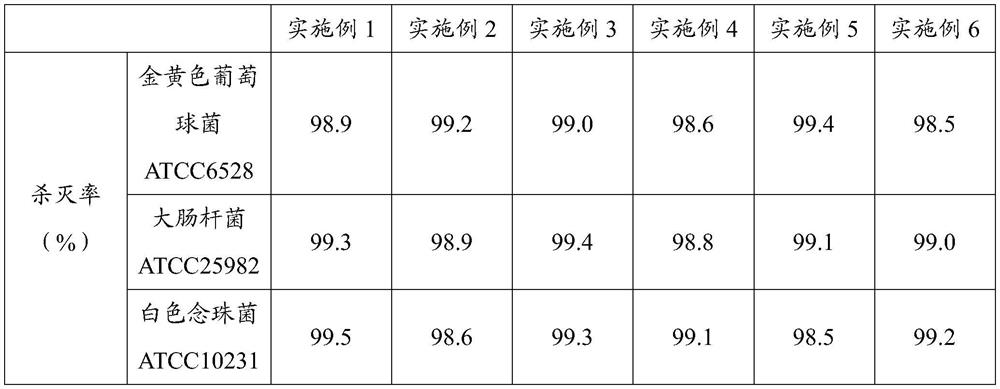Textile antibacterial agent and application thereof
An antibacterial agent and textile technology, applied in the field of textile antibacterial, can solve the problems of inability to use broad-spectrum and long-term effect, limited antibacterial effect, poor heat resistance, etc.
- Summary
- Abstract
- Description
- Claims
- Application Information
AI Technical Summary
Problems solved by technology
Method used
Image
Examples
Embodiment 1
[0028] According to the ratio of material to liquid: 1g: 6mL, distill juniper in 1wt.% sodium chloride solution for 3h to obtain juniper oil; then mash the dry heartwood of hematoxylin and decoct it, and then use 60wt.% ethanol solution Extraction, centrifugation after extraction, and concentrating the supernatant to obtain hematoxylin extract.
[0029] Mix 2.5g of carboxylated chitosan with a deacetylation degree of 75% into 100g of water, stir evenly under continuous heating conditions, and stir at constant temperature under boiling conditions for 15min; stop heating, and add 1.5g when the temperature drops to 40°C Juniper oil and 2g hematoxylin extract were continuously stirred evenly, and then slowly added 8g dilute acetic acid as a pH regulator to adjust the pH to 6.5, and finally stirred evenly at room temperature to obtain the textile antibacterial agent.
[0030] Utilize this textile antibacterial agent to carry out antibacterial finishing, the steps are as follows: pa...
Embodiment 2
[0032] According to the ratio of material to liquid 1g: 6mL, distill juniper in 1.5wt.% sodium chloride solution for 3h to obtain juniper oil; then mash the dry heartwood of sumac and decoct, then use 50wt.% ethanol solution Extraction is carried out, centrifuged after extraction, and supernatant is concentrated to obtain hematoxylin extract.
[0033] Mix 4.5g of carboxylated chitosan with a deacetylation degree of 80% into 120g of water, stir evenly under continuous heating conditions, and stir at constant temperature under boiling conditions for 20min; stop heating, and add 1.8g when the temperature drops to 50°C Juniper oil and 3g hematoxylin extract were continuously stirred evenly, and then slowly added 10g citric acid as a pH regulator to adjust the pH to 6.2, and finally stirred evenly at room temperature to obtain the textile antibacterial agent.
[0034] Utilize this textile antibacterial agent to carry out antibacterial finishing, the steps are as follows: padding: p...
Embodiment 3
[0036] According to the ratio of material to liquid 1g: 6mL, distill juniper cypress in 2wt.% sodium chloride solution for 3.5h to obtain juniper oil; then mash the dry heartwood of sumac and decoct it, and then use 55wt.% ethanol solution Extraction is carried out, centrifuged after extraction, and supernatant is concentrated to obtain hematoxylin extract.
[0037] Mix 6.5g of chitosan sulfate with a deacetylation degree of 75% into 140g of water, stir evenly under continuous heating, and stir at a constant temperature for 20min under boiling conditions; stop heating, and add 2g juniper when the temperature drops to 40°C Asphalt and 4g hematoxylin extract, after continuous stirring evenly, slowly add 12g dilute hydrochloric acid as a pH regulator to adjust the pH to 6.2, and finally stir evenly at room temperature to obtain the textile antibacterial agent.
[0038]Utilize this textile antibacterial agent to carry out antibacterial finishing, the steps are as follows: padding:...
PUM
 Login to View More
Login to View More Abstract
Description
Claims
Application Information
 Login to View More
Login to View More - R&D
- Intellectual Property
- Life Sciences
- Materials
- Tech Scout
- Unparalleled Data Quality
- Higher Quality Content
- 60% Fewer Hallucinations
Browse by: Latest US Patents, China's latest patents, Technical Efficacy Thesaurus, Application Domain, Technology Topic, Popular Technical Reports.
© 2025 PatSnap. All rights reserved.Legal|Privacy policy|Modern Slavery Act Transparency Statement|Sitemap|About US| Contact US: help@patsnap.com

